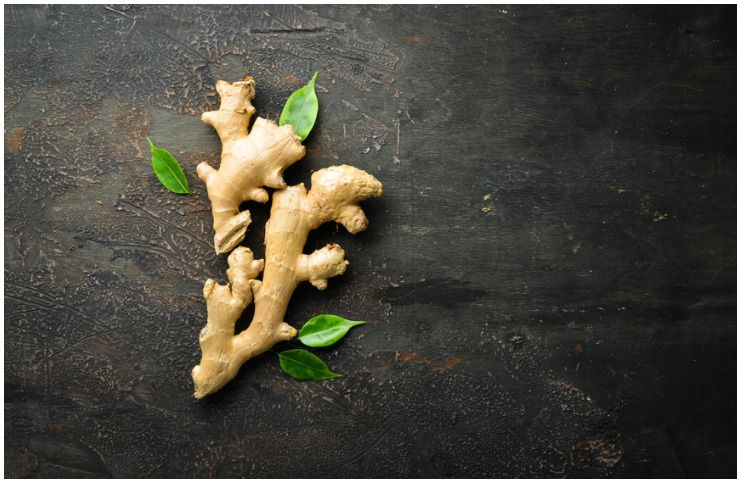Ginseng vs Ginger – Health Benefits, Nutrition Facts, Side Effects:
Ginseng
It is one of the most popular herbal medicines in the world and is usually found in certain cooler areas of Asia and North America.
This root has been used in North America and Asia for millennia. There are two main types: American ginseng (Panax quinquefolius) and Korean or Asian (Panax ginseng).
This root is considered to lower LDL cholesterol and blood sugar levels, boost energy, promote relaxation, reduce stress, and manage erectile dysfunction in men.
Nutrition Facts
It contains 25 saponins called ginsenosides, glycans (panaxans), flavonoids, peptides, maltol, vitamins A (in the form of carotenoids), polysaccharide fraction DPG-3-2, volatile oils, vitamins B6, and zinc.
Health Benefits
Lung Cancer
More people in the US die from lung cancer than any other type of cancer. For example, according to the CDC, 155,526 Americans died from lung cancer, including 70,667 women and 84,859 men, in 2016.
An extract containing this root increases cancer cell death in lung cancer cells, inhibiting tumor growth, as per a recent study.
Diabetes
Diabetes is a common condition in which the amount of glucose in the blood is too high since the body can’t use it correctly.
More than 31 million Americans have diabetes, and approximately 85 million adults (34 percent of adults) aged 18 years or older have prediabetes.
By regulating the intake or absorption of sugar, this spice is able to protect the human body from sudden spikes in blood glucose.
Cold & Flu
Both are caused by viruses, however, completely different ones. Only three strains can cause flu, but there are hundreds of viruses that can cause colds.
According to a 2014 study, seniors who took an extract containing this root had about a 55% reduction in duration and a fifty percent reduction in relative risk of this type of respiratory illness.
Side Effects And Precautions
A supplement containing an extract from this root can be safely taken in doses of 200mg to 400mg per day. Due to the fact that it is a very powerful spice, long-term use or high doses may have the following side effects:
-
- delirium;
- sleep problems;
- severe skin reaction;
- headaches;
- bleeding;
- digestive problems;
- dizziness;
- blurred vision;
- changes to blood pressure;
- seizures and convulsions;
- decreased heart rate;
- dry mouth;
- diarrhea;
- edema (abnormal accumulation of fluid in the space between tissues);
- irritability;
- nervousness.
Because this spice may affect blood glucose levels, individuals taking prescription medicines (such as Metformin) for type 2 diabetes mellitus should not use this root without talking to their healthcare provider first.
There are no studies regarding its efficacy and safety in pregnancy and lactation.
Ginger
It is a potent aromatic herb that is commonly produced in Jamaica, India, Indonesia, Fiji, and Australia and is part of the Zingiberaceae family, alongside turmeric and cardamom.
Due to its medicinal properties, this root was a priceless commodity during the Roman Empire trade around the coming of Christ. Furthermore, the Indians and the Chinese have used it to treat a variety of ailments for more than 4,600 years.
The root can be consumed in oil form, powdered, fresh, dried as a spice, or as juice.
Nutrition Facts
It is a good source of vitamin C, potassium, folate, copper, selenium, magnesium, thiamin, riboflavin, and manganese. The primary bioactive ingredient in this root is called gingerol.
Health Benefits
Stomach Problems
It is used to treat vomiting and nausea linked with mild symptoms of pregnancy sickness (one of the most common pregnancy symptoms). Moreover, this spice may reduce the signs and symptoms linked to motion sickness, such as – nausea, dizziness, cold sweating, and vomiting.
Anti-inflammatory Properties
An acute inflammatory reaction occurs in response to an infection or after a traumatic injury. The problem is chronic inflammation, that is caused by an unhealthy diet, by a long-term infection, or by immune dysregulation.
This root is linked with reducing chronic inflammation levels, most likely due to its content of gingerol.
Cardiovascular Health
The active compounds in this root can help reduce LDL and total cholesterol levels, which are strongly associated with a higher incidence of heart disease.
Additionally, it prevents blood clots from being formed in the blood vessels and arteries. This is an important aspect since blood clots are serious and most frequently occur in individuals who have had recent surgery or who can’t move around well.
Alzheimer’s Disease
About 10 percent of all Americans over 65 have Alzheimer’s disease, a chronic neurodegenerative disease that is the sixth leading cause of death in the US.
An individual with AD disease may:
- become more hesitant to try new things;
- become less flexible;
- forget about recent events or conversations;
- find it harder to make decisions;
- show poor judgment;
- ask questions repetitively;
- misplace items;
- have trouble thinking of the right word;
- forget the names of objects and places.
According to some studies, regular consumption of this spice can help slow down the loss of brain cells, which usually leads to this serious condition.
Side Effects And Precautions
The ideal dosage for consuming this spice could be anywhere between 250 mg to 1 gram several times per day. Exceeding this amount can result in side effects with symptoms including:
- burning in the mouth;
- stomach ache;
- gas.
Ginseng vs Ginger – Differences
These spices taste very different, plus, they have different therapeutic effects on the human body.
For instance, ginger is especially beneficial for digestive problems, while ginseng boosts energy levels as well as reduces blood sugar levels.
READ THIS NEXT:
Subungual Hematoma vs Melanoma
References https://www.ncbi.nlm.nih.gov/pmc/articles/PMC3665023/ https://www.sciencedirect.com/science/article/pii/S106345841401276X https://www.hindawi.com/journals/grp/2015/142979/
